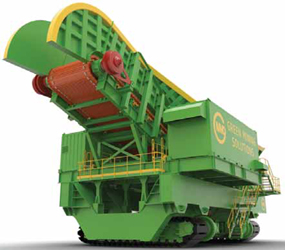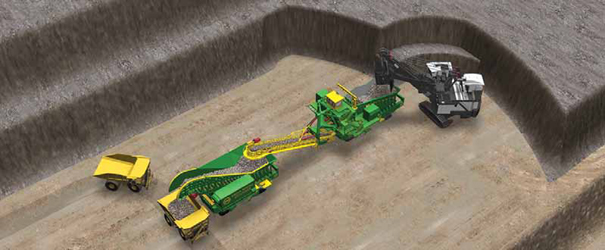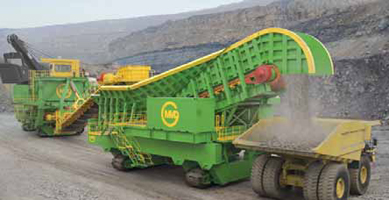
New mining methods would use a Surge Loader for overburden or waste (top) and a Fully Mobile Sizer Station
and Surge Loader for ore (bottom). Patent Pending; UK Patent Application No 1709467.3
A New Approach to Truck and Shovel
Mining
Employing a Surge Loader working in tandem with a Fully Mobile Sizing Station,
open-pit miners could soon realize the continuous mining benefits of in-pit sizing,
while using their existing truck fleet for haulage
By Steve Fiscor, Editor-in-Chief

About 12 years ago, MMD built an apron feeder for a Colombian coal operation that accepted loads directly from a dragline. It proved robust enough to process the overburden and load the haul trucks. More recently, MMD installed a fully mobile In-Pit Sizing and Conveying (IPSC) system at a Chinese mine. Now they have combined the experience from both of those operations to develop a set-up that lets the shovel dig continuously.
Open-pit mines constantly struggle to properly pass match trucks and shovels, David Pitchford, president, MMD Mineral Sizing Americas, explained. “There is a lot of room for improvement as far as accuracy and efficiency,” Pitchford said. “Trucks rarely reach 90% of their fill factor and most shovels rarely load at 6,000 tons per hour (t/h) when they should be loading at 10,000 t/h because they are waiting on trucks.”
At the time, the Colombian mine could not purchase a shovel due to long lead times, so they improvised and with MMD’s help developed an alternative system. “The trucks drive under a hydraulically powered feeder, which can be started and stopped immediately,” Pitchford said. “We could load trucks three times faster. What we also found was that we could load trucks accurately [98% fill factor]. The system also eliminated the time consumed in reversing the trucks into their loading position. The trucks fall in line and it takes about 75 seconds to load them precisely.”

At that point, Pitchford knew MMD could connect trucks and shovels with a continuous loading system. The IPSC system in China feeds a conveyor system, but he knew mines with large truck-shovel fleets would not simply replace their equipment with conveyors after making that investment, plus they would have to redesign the pits. Combining the experience in Colombia and China with the feeder and the IPSC technology, MMD developed the Surge Loader and Fully Mobile Sizing Station for loading trucks.
Developing a New
Continuous System
To crack the nut, MMD needed to design a
piece of a kit that would sit next to the shovel,
and make it mobile to move along with
the shovel, so the mine can use the shovel to
its maximum capacity, Pitchford reasoned.
Moving overburden, however, can be different from mining ore. Therefore,MMD also began to work on a straightforward concept where the shovel works directly with the Surge Loader, which in turn loads the haul trucks in a very quick and precise manner.
MMD flew a group of South American copper miners to China to see their IPSC technology in action. They wanted to mine ore in a similar fashion and they have now decided on a 12-month pilot program to monitor the production of the shovel working in tandem with the Mobile Sizing Station.

This form of continuous mining would allow an operation to mine from benches in the exact same manner as they would with trucks while sizing ore at the face.
“We have done a lot more work as far as being able to relocate this system quickly,” Pitchford said. “We are looking at some ‘Star Wars’ like ideas as far as spotting the trucks. We are trying to set this up where the shovel operator sees the monitor and, after the shovel is moved into position and the operator sees all the other equipment is lined up properly, he can start loading and keep loading until the surge loader is waiting for trucks. As long as trucks are passing through, they can keep feeding.”
If the shovel operator makes sure the Mobile Sizing Station is fully charged, it will allow him enough time to reposition the shovel and restart mining operations again, Pitchford explained.
The current Fully Mobile Sizer Station combines a D9 Heavy Duty Apron Plate Feeder with a 1500 Series Twin Shaft Mineral Sizer, a transfer belt and luffing (or slewing) conveyor. Both belts are rubber, and they can slew that conveyor into any position for the surge loader up to 60°.
From the bridge above the Mobile Sizer Station, the operator can monitor everything that is happening between the shovel the Sizer Station and the Surge Loader. If the system stalls for whatever reason, the operator can reverse and restart it. “The Sizer Station operator, however, can’t see the situation with the truck,” Pitchford said. “So, the plan for now is to place a system on the shovel. If the shovel operator sees no truck and that the Mobile Sizer Station’s hopper is full in front to him, he can stop loading. The Surge Loader will have stopped because there are no trucks in position and the Mobile Sizer Station will not run if the Surge feeder is not running.

The system can load trucks with one operator accurately. The truck can sense the load and signal the feeder to stop at full payload. The shovel never waits in this setup. The dump area for the Mobile Sizer Station is the same shape as a 350-ton truck. The shovel swing passes remain in the 90° to 120° range and it can run 24/7.
Productivity Increases
To prove his thesis, Pitchford used a
production modelling system to compare
the loading process with conventional
techniques. “We talked to miners to get
as much input as we could, to develop
software to determine actual production
run rates,” Pitchford said. “The software
[Arena] told us exactly what would happen.
Using all of the information, it generated
a simulation of trucks loaded in a traditional
fashion and compared it to trucks
being loaded using MMD equipment and we saw that
the Surge Loader system immediately outpaces
the traditional loading method.”
“Using our models, we are seeing approximately a 12- to 14-load-per-hour improvement in the shovel’s capability,” Pitchford said. “That’s the shovel loading at maximum capacity compared to the normal cycle of 3.5 loads per truck. Every fourth bucket in that loading arrangement is a half load.”
This form of mining should also be a much safer scenario as far as the truck drivers not getting anywhere near the shovel.
A large open-pit mine could employ several Surge Loaders and a Fully Mobile Sizer Station. The operation could mine from multiple benches using the Sizer-Surge Loader arrangement for ore and then use the Surge Loader independently for moving waste rock. “We see the main market as moving material with a shovel and a Surge Loader,” Pitchford said. “With every shovel, the mine would want to have a Surge Loader and then in the ore they would want to have a Mobile Sizing Station.”
As for the economics, if a mine has seven shovels, Pitchford said they can produce the same amount with five using this system - They can also use less trucks to move the same amount of dirt.
For more information visit www.mmdsizers.com